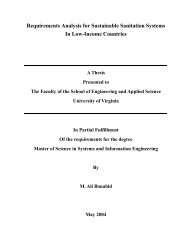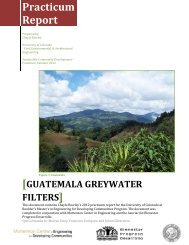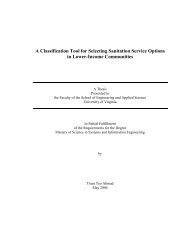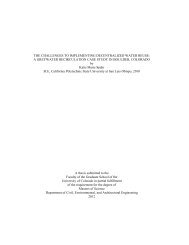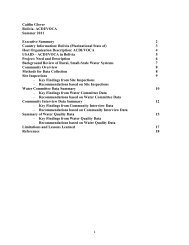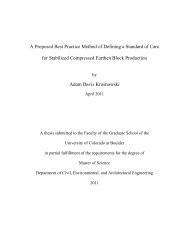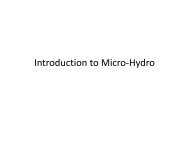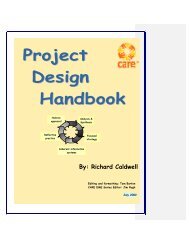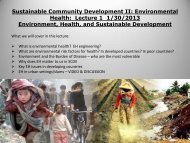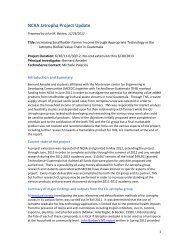Field Testing of Various Microbial Fuel Cell ... - Mortenson Center
Field Testing of Various Microbial Fuel Cell ... - Mortenson Center
Field Testing of Various Microbial Fuel Cell ... - Mortenson Center
You also want an ePaper? Increase the reach of your titles
YUMPU automatically turns print PDFs into web optimized ePapers that Google loves.
<strong>Field</strong> <strong>Testing</strong> <strong>of</strong><br />
<strong>Various</strong> <strong>Microbial</strong> <strong>Fuel</strong><br />
<strong>Cell</strong> Designs<br />
Kampala, Uganda<br />
Acknowledgements:<br />
• Zhigong (Jason) Ren, Associate<br />
Pr<strong>of</strong>essor <strong>of</strong> Engineering, University <strong>of</strong><br />
Colorado-Denver<br />
• Water For People, Kampala, Uganda<br />
Funding Provided by the Following:<br />
• The <strong>Mortenson</strong> <strong>Center</strong><br />
• Water for People<br />
• Bill & Melinda Gates Foundation<br />
James Perlow<br />
October 20, 2012
Executive Summary<br />
<strong>Microbial</strong> fuel cell (MFC) technology harvests the energy produced by microbes as they degrade<br />
human waste. This energy is converted to electricity and can be used as a renewable power<br />
source for lights or other low demand applications. The challenge facing this technology is how<br />
to take it from the laboratory to the natural environment, most crucially, how to make this<br />
technology affordable.<br />
This project, funded by the Mortensen <strong>Center</strong> in Engineering for Developing Communities<br />
University <strong>of</strong> Colorado at Boulder, Water for People and the Gates Foundation through the<br />
University <strong>of</strong> Colorado at Denver, addressed these issues. The ultimate goal <strong>of</strong> these agencies is<br />
to improve people’s lives through sanitation improvements in developing countries and to<br />
provide a renewable energy source at a low cost.<br />
To try and achieve these goals, four different MFC designs were pilot tested in different physical<br />
environments. The project approach was to incorporate the Appraisal-Design-Intervention-<br />
Monitoring & Evaluation development principles. These principles are a cyclic process in which<br />
information is continually being evaluated and adjustments are made to the project to help it<br />
succeed in the context <strong>of</strong> working within a developing community. The different designs were<br />
either tested in a toilet comprised mostly <strong>of</strong> liquid or solids. All four designs were constructed<br />
with locally purchased materials. The goal <strong>of</strong> generating renewable energy was simplified to the<br />
level <strong>of</strong> generating enough power to visibly demonstrate the technology works and then start<br />
redesigning the MFC’s to increase power output. One design placed in a septic tank produced<br />
enough power to make a small light blink. This was considered a success because concepts<br />
discovered in laboratory were proven to work in the field. That coupled with recent advances in<br />
the laboratory increasing power output leads to the next phase <strong>of</strong> research, designing a self<br />
contain MFC that produces more power. The pilot tests were started in June 2012 and are<br />
ongoing with support from local community members and Water for People staff.<br />
Future work will involve creating a prototype that can meet the demands <strong>of</strong> a septic tank<br />
environment and increase the power output. Investigation <strong>of</strong> potential commercial markets also<br />
needs researching. These issues are currently being worked on to understand the potential and<br />
ii
limits <strong>of</strong> MFC technology placed in an environment with a need for a small amount <strong>of</strong> renewable<br />
energy.<br />
iii
Contents<br />
Project Background ....................................................................................................................................... 1<br />
iv<br />
Appraisal/Analysis Phase .......................................................................................................................... 4<br />
Community Descriptions ...................................................................................................................... 4<br />
Strategy and Design ...................................................................................................................................... 7<br />
Project Objectives ..................................................................................................................................... 7<br />
Description <strong>of</strong> Project Activities ............................................................................................................... 8<br />
MFC Designs ............................................................................................................................................ 9<br />
Control Design .................................................................................................................................... 10<br />
Septic Design ...................................................................................................................................... 10<br />
Drum Inside a Drum Design ............................................................................................................... 10<br />
Pour-n-Flush Design ........................................................................................................................... 11<br />
Pit Latrine Design ............................................................................................................................... 11<br />
Costs ........................................................................................................................................................ 12<br />
Monitoring and Evaluation ......................................................................................................................... 12<br />
Control Design for Quality Control and Assurance ................................................................................ 13<br />
Septic Design .......................................................................................................................................... 15<br />
Drum Inside a Drum Design ................................................................................................................... 16<br />
Pour-n-Flush Design ............................................................................................................................... 16<br />
Pit Latrine Design ................................................................................................................................... 17<br />
Project Exit Strategy ............................................................................................................................... 18<br />
Key Findings ............................................................................................................................................... 18<br />
Lessons Learned.......................................................................................................................................... 18<br />
Conclusions ................................................................................................................................................. 19<br />
Recommendations ....................................................................................................................................... 20<br />
Authors Notes ............................................................................................................................................. 21<br />
Bibliography ............................................................................................................................................... 22
Tables<br />
Table 1: Stakeholders……………………….…………………………………………………………..….5<br />
Table 2: Problems and Solutions…………………………………………………………..………...……..6<br />
Table 3: Logical Framework…………..………………………………………………………………..….7<br />
Table 4: MFC's Design Costs (in US dollars)……………………………………………………………..12<br />
Table 5: Typical Wastewater Characteristics………………………………….…………………………..14<br />
Table 6: Control Designs Results………………………………………………………………………….15<br />
Table 7: Septic Design Results……………...………………………………………………………....….16<br />
Table 8: Pour-n-Flush Design Results………………………………………………………………….....17<br />
Figures<br />
Figure 1: MFC Schematic (Logan B. , 2008) ............................................................................................... 1<br />
Figure 2: Pit Latrine on left; Pour-n-Flush on Right (Harvey, Baghri, & Reed, 2002) ................................ 5<br />
Figure 3: Septic Design Laboratory Results ............................................................................................... 13<br />
Appendix A: Photographic Log<br />
v
Project Background<br />
Harvesting the electrons and protons released by microbes as they degrade waste to generate<br />
electricity is a largely untapped renewable energy source. Currently, researchers are investigating<br />
ways to reap the energy with no power input. They have shown this can be accomplished using<br />
microbial fuel cells (MFC) to capture energy and convert it to useful electricity. MFCs harvest<br />
the protons and electrons released from microbes as they degrade organic carbon and convert the<br />
energy into electricity. Microbes oxidize a substrate (carbon in human waste) and convert it to<br />
CO2 or methane. Human waste contains approximately 23 MJ/kg per dry stool depending on diet<br />
(Murphy, Wootton, & Jackson, 1993) which is approximately equal to the energy stored in coal<br />
(Weststeijn, 2002). This amount <strong>of</strong> power can translate to one person being able to generate<br />
approximately 25 Watts and a family <strong>of</strong> four, 100 Watts, which is enough energy to power a<br />
small incandescent light bulb (Logan B. , 2008). Getting electrons to flow to an anode and<br />
reacting with oxygen (electron receptor) and protons to flow to cathode is the premise behind the<br />
technology as shown in Figure 1.<br />
Figure 1: MFC Schematic (Logan B. , 2008)<br />
Microbes transfer electrons exogeneously to an anode via different methods. For example,<br />
conductive appendages called nanowires, discovered in 2005, transfer electrons, as does a<br />
process called cell-surface transfer (Gorby & Yanina, 2006). <strong>Cell</strong>-surface transfer occurs when<br />
1
the surface <strong>of</strong> a cell is physically in contact with any surface and bio-film growth on an anode is<br />
ideal for electron transfer this way in MFCs. Certain bacteria such as Pseudomonas aeruginosa<br />
found in wastewater can shuttle electrons from the cell to a physical surface such as an anode<br />
using mediators which are essentially electron shuttles. This process is currently not well<br />
understood. To gain the most advantage from these three processes, many different anode<br />
materials have been studied. An anode that has a large surface area, is highly conductive and<br />
porous, is non-corrosive, and has low internal resistance seems to be the most effective at<br />
transferring electrons. The limiting factor in the production <strong>of</strong> electricity with MFC technology<br />
on a large scale currently is not the anode, but the design and material used for the cathode.<br />
The chemical reaction that occurs at or on the cathode is a three phase reaction between a<br />
catalyst, water, and oxygen, shown in equation 1.<br />
2<br />
O2(g) + 4H + + 4e - = 2H2O eq (1)<br />
The free energy released during this reaction can be harvested in the form <strong>of</strong> electricity. The<br />
electricity generated is in the form <strong>of</strong> direct current (DC). The cathode material acts as the<br />
catalyst, lowering the activation energy required to make the reaction rate increase. Platinum is<br />
frequently used as a catalyst, but is very expensive and subject to sulfide poisoning from<br />
wastewater and therefore prohibitive for large scale applications (Feguia, et al., 2007). Chemical<br />
oxidizers such as ferricyanide have been used as the oxidizing agent in cathode chambers,<br />
producing some <strong>of</strong> the highest energy outputs, but ferricyanide needs to be replenished because it<br />
is converted to ferrocyanide. Overcoming obstacles like these has led researchers to try to find<br />
efficient cathode materials and designs that utilize oxygen as the oxidizing agent, since there is a<br />
free, unlimited supply and because oxygen has a high oxidation potential. However, oxygen has<br />
limitations as well as benefits—for example, it requires a high activation energy to be oxidized to<br />
water and it can never exceed saturation dissolved in water (7.8 mg/l at 25°C) since the cathode<br />
needs to be covered by a liquid to allow for proton transfer (Liu, Ramnarayanan, & Logan,<br />
2004). Additionally, oxygen reduction requires high activation energy, which leads to<br />
overpotential (difference between open and closed circuit potentials), thus limiting the transfer <strong>of</strong><br />
electrons.<br />
To create an environment that can harvest the energy and overcome the limiting factors <strong>of</strong><br />
electron transfer, scientists are experimenting with many different MFC designs. The
architecture <strong>of</strong> MFCs’ is currently changing to become more efficient, but most are either a dual<br />
or single chamber reactor.<br />
The dual chamber reactor consists <strong>of</strong> an anode chamber containing the substrate and microbes<br />
and a cathode chamber containing an oxidizing agent (dissolved oxygen) and the cathode. They<br />
are divided by a cation exchange membrane (CEM), which allows protons to move between the<br />
two chambers, but restricts the exchange <strong>of</strong> the media. A single chamber reactor consists <strong>of</strong> an<br />
anode separated from the cathode only by distance in the media they are placed as opposed to<br />
dual chamber design which has a membrane separating the chambers. This limits the cathode to<br />
only utilize oxygen as the oxidant. Before treatment, raw wastewater contains an abundance <strong>of</strong><br />
organic carbon and microbes, which makes MFC technology a promising solution for a<br />
renewable energy system. Several variations <strong>of</strong> the single chamber designs were installed in two<br />
different environments within Kampala, Uganda as part <strong>of</strong> this project.<br />
The project was conducted with collaboration from the Gates Foundation who awarded the<br />
University <strong>of</strong> Colorado at Denver grant/research money as part <strong>of</strong> their grand challenge to<br />
reinvent the toilet. The <strong>Mortenson</strong> <strong>Center</strong> at the University <strong>of</strong> Colorado at Boulder funded travel<br />
expenses and the Water for People (WFP) field <strong>of</strong>fice located in Kampala, Uganda provided<br />
community introductions and appraisal, technical and financial support, and field testing<br />
facilities. Pilot test were conducted between June 13 and July 18, 2012.<br />
The pilot tests were conducted in two different environments. The first was a secure easy to<br />
access environment where a high level <strong>of</strong> control over the tests could be maintained. The second<br />
testing area was located in a low income developing neighborhood within Kampala. The pilot<br />
tests conducted within the neighborhood were designed to incorporate the project plan <strong>of</strong><br />
Appraisal/Analysis- Design/ Strategy-Intervention-Monitoring & Evaluation (ADIME)<br />
development framework. The ADIME framework is a cyclic process. Information gathered<br />
during each stage is evaluated and the cause and effects are incorporated back into the project<br />
cycle. In this way adjusts can be made to the project to navigate obstacles and the project can be<br />
sustainable. The initial stage <strong>of</strong> the project was to indentify a community that could potential<br />
benefit from the technology and had the capacity to help implement the pilot tests. WFP, a non-<br />
3
governmental organization with strong ties in Kampala, located the community and helped with<br />
this initial stage.<br />
Appraisal/Analysis Phase<br />
Prior to the implementation <strong>of</strong> the project, discussions were held with WFP identifying possible<br />
locations for the pilot tests. One site was identified behind the <strong>of</strong>fice <strong>of</strong> WFP where the pilot tests<br />
could be conducted in a very controlled field environment and the second site was a developing<br />
low income neighborhood in Kampala. The neighborhood was identified by WFP who had<br />
previously worked in this community and had conducted a community appraisal.<br />
Community Descriptions<br />
Pilot tests were conducted in Kampala, Uganda either behind the Water for People <strong>of</strong>fice in the<br />
Kitante section <strong>of</strong> the city or in the Nsambya neighborhood. Kitante is near the Kampala city<br />
center and, in addition to the WFP <strong>of</strong>fice, also hosts the British High Commission, Uganda<br />
National Museum and the Rwandese Embassy. The WFP <strong>of</strong>fice consists <strong>of</strong> an <strong>of</strong>fice building<br />
serving nine people. Public water is supplied and the sanitation consists <strong>of</strong> two indoor toilets<br />
which when flushed flow to a septic tank before entering the public sewer system.<br />
4<br />
The Nsambya neighborhood is located approximately three miles south-southeast <strong>of</strong> the central<br />
business district. The neighborhood is located at the bottom <strong>of</strong> a hill built in an area with a very<br />
high water table. Portions <strong>of</strong> the neighborhood are wetlands. There is access to metered private<br />
water taps and several unprotected springs. There is no public sanitation and people use family or<br />
community owned pit latrines and/or pour-n-flush toilets. Figure 2 shows designs <strong>of</strong> both the pit
2002)<br />
latrine and pour-n-flush toilets.<br />
Figure 2: Pit Latrine on left; Pour-n-Flush on Right (Harvey, Baghri, & Reed,<br />
Sewer water (black water) that leak from the pit latrines and/or pour-n-flush toilets flows through<br />
open channels into the wetlands. Unemployment and population density are high in Nsambya.<br />
Schools are located within the community and the most common forms <strong>of</strong> transportation are<br />
private car or motorcycles for hire.<br />
The project stakeholders within Nsambya are shown in Table 1.<br />
Table 1: Stakeholders<br />
Stakeholders Contribution Stake<br />
Chief <strong>of</strong> Defense- Waliggo<br />
Joseph<br />
Local Artisan- Isaac<br />
Namakoola<br />
Community leader who is a<br />
government <strong>of</strong>ficial. The<br />
community defers to him to<br />
resolve issues and he is very<br />
familiar with families and the<br />
living conditions. He is able to<br />
provide suggestions to which<br />
families or compounds may<br />
provide the best test locations.<br />
Highest local government<br />
<strong>of</strong>ficial and by giving his<br />
approval to a location<br />
increased his perception <strong>of</strong><br />
power.<br />
Help install pilot test Reputation within the<br />
community as a successful<br />
artisan. Potentially lead to<br />
5
Informal Leader- Sam Nangoli Locating families with ideal<br />
test locations and navigation<br />
through the neighborhood and<br />
6<br />
making introductions<br />
Water For People Stays actively involved in the<br />
community. Can be utilized<br />
for many different resources<br />
more employment<br />
opportunities and he hires<br />
from within the community.<br />
Currently viewed by other<br />
members <strong>of</strong> the community as<br />
a forward thinker and helps<br />
solidify his position<br />
Continues their relationship<br />
and gains more good will in<br />
the community.<br />
Property Manager-Moses Keeps the pilot tests running Gains more respect from the<br />
families that share the latrines<br />
and will be utilized for next<br />
phase <strong>of</strong> testing.<br />
The pilot tests had several obstacles to navigate. Some problems were identified by WFP after<br />
the community appraisal, but others were identified after an initial site walk through the<br />
community. Solutions were developed and applied to the project. The problems and solution are<br />
listed in Table 2.<br />
Table 2: Problems and Solutions<br />
Problem Problem Detail Solution<br />
Find Locally Sourced Material To meet the philosophy <strong>of</strong> the<br />
funder the pilot tests needed to<br />
be constructed <strong>of</strong> local<br />
obtained material<br />
Find Ideal Test Sites Personal or communities<br />
bathrooms needed to meet<br />
criteria <strong>of</strong> the pilot tests<br />
specifications.<br />
Correct Bathroom Use Urine need to be poured down<br />
the cathode for aeration.<br />
Education <strong>of</strong> Equipment Use People needed to understand<br />
the system in order to care and<br />
monitor the pilot tests.<br />
Test Monitoring Understand the measurements<br />
and how they are collected<br />
Continuation <strong>of</strong> Project Having the pilots test continue<br />
after oversight leaves.<br />
Employed the help <strong>of</strong> a local<br />
welder to secure material and<br />
identify businesses selling the<br />
required items<br />
Utilize Chief <strong>of</strong> Defense and<br />
informal leader to identify<br />
ideal test sites<br />
Hold a couple behavior<br />
training classes with the<br />
participating people and place<br />
signs next to cathode in native<br />
language<br />
Hold training succession<br />
Make it part <strong>of</strong> the education<br />
and training process<br />
Keep the communication<br />
channels open and frequently<br />
verbally reach out.
Strategy and Design<br />
Project Objectives<br />
The objective <strong>of</strong> the project was to build MFC’s from locally sourced material and to generate a<br />
measurable amount <strong>of</strong> electricity from the system. The overall strategy <strong>of</strong> the project and<br />
indicators <strong>of</strong> project success are indentified in Table 3. Table is a logical framework <strong>of</strong> the<br />
project goals and ultimately the indicators tying together all the components <strong>of</strong> the project.<br />
Table 3: Logical Framework<br />
Goals Objectives Outputs Activities Inputs Indicators<br />
Generate a<br />
measurable<br />
amount <strong>of</strong><br />
electricity<br />
using MFC<br />
Technology<br />
placed in<br />
human waste<br />
Use only<br />
material<br />
found locally<br />
Track system<br />
costs<br />
Locate a<br />
control<br />
environment<br />
to test MFC<br />
Locate a<br />
community<br />
environment<br />
to test MFC<br />
Gage<br />
community<br />
Interest in<br />
Technology<br />
Build MFC Search<br />
markets and<br />
incorporate<br />
local people<br />
with<br />
specialized<br />
Know what a<br />
complete<br />
system would<br />
cost<br />
Safe and easy<br />
to monitor<br />
pilot tests site<br />
Real world<br />
system<br />
testing in a<br />
family or<br />
community<br />
toilets<br />
People stating<br />
they would<br />
pay for a<br />
system that<br />
knowledge<br />
Buy only<br />
local material<br />
Investigate<br />
the area and<br />
physical<br />
observe the<br />
site<br />
Identify a<br />
community<br />
and/or family<br />
with the<br />
capacity to<br />
support the<br />
pilot test<br />
Walk through<br />
neighborhood<br />
identifying<br />
how many<br />
Supply<br />
necessary<br />
transportation<br />
and funds<br />
Money to buy<br />
material<br />
Discuss<br />
options with<br />
WFP who has<br />
local<br />
knowledge<br />
Community<br />
appraisal and<br />
meet with<br />
individual pit<br />
latrine owners.<br />
Introductions<br />
made by<br />
informal<br />
leader<br />
Provide an<br />
overview <strong>of</strong><br />
what the<br />
technology can<br />
Completely<br />
built system<br />
Everything<br />
was<br />
purchased<br />
locally and<br />
system cost<br />
could be<br />
evaluated<br />
24 hour<br />
security and<br />
easy access to<br />
septic tank<br />
and other<br />
project<br />
necessities<br />
Toilets can<br />
house pilot<br />
test<br />
equipment<br />
and on-site<br />
monitoring is<br />
being<br />
completed<br />
Public<br />
support and<br />
long-term<br />
interest in the<br />
7
8<br />
can supply<br />
inexpensive<br />
electricity<br />
Description <strong>of</strong> Project Activities<br />
places are<br />
without<br />
access to<br />
electricity<br />
do through<br />
visual and<br />
verbal<br />
demonstrations<br />
Two general MFC concepts were explored. The first concept was to build MFC’s to take<br />
test indicated<br />
by<br />
involvement<br />
and<br />
monitoring<br />
advantage <strong>of</strong> the liquid environment found in a waste tank which is predominately liquid with<br />
solids at the bottom. The mass transfer <strong>of</strong> electrons and protons are more efficient in a liquid<br />
medium and the solids at the bottom <strong>of</strong> the tank provide for an anaerobic environment that is<br />
favorable for microbes to release the largest amount <strong>of</strong> electrons. The second design concept was<br />
to build an MFC in a pit latrine comprised mostly <strong>of</strong> solids. An environment comprised <strong>of</strong><br />
mostly solids makes it more challenging to get the mass transfer needed to generate sufficient<br />
electricity, but has the capacity <strong>of</strong> producing greater amounts <strong>of</strong> energy since the human solid<br />
waste provides a larger carbon source for microbes. Different MFC designs were created to<br />
explore the feasibility <strong>of</strong> the technology and were monitored to evaluate their performance and<br />
maximize voltage output.<br />
Suitable test sites were found that provided these two different latrine environments. The secure<br />
environment behind WFP <strong>of</strong>fice was chosen as one <strong>of</strong> the test sites because <strong>of</strong> 24 hour security<br />
and ease <strong>of</strong> access to the onsite septic tank. This site also provided an environment that was easy<br />
to monitor. For these reasons a control experiment was constructed to mimic MFC’s created in<br />
the University <strong>of</strong> Colorado Denver laboratory at the WFP <strong>of</strong>fice. The ease <strong>of</strong> access and control<br />
made it ideal to test different MFC material. The second test location was located in Nsambya<br />
where the community was more reflective <strong>of</strong> the people that would be targeted for this<br />
technology if a market solution was determined to be feasible. Selections <strong>of</strong> sites in Nsambya<br />
were made after going through a community evaluation.<br />
Before selecting test sites in Nsambya, a local artisan named Isaac Namakoola was recommend<br />
by WFP to provide introductions to the community. The artisan understood the community<br />
dynamics and who the stakeholders were that could help achieve the goals <strong>of</strong> the project. He<br />
introductions to informal community leader Sam Nangoli who became crucial in finding
potential sites because <strong>of</strong> his knowledge <strong>of</strong> the community and family structures that used the<br />
different latrines. He made introductions to the Chief <strong>of</strong> Community Defense Waliggo Joseph,<br />
who was one <strong>of</strong> the community’s most respect members. The Chief <strong>of</strong> Community Defense was<br />
very interested in the project and suggested several locations. Based upon the needs <strong>of</strong> the<br />
project, Isaac Namakoola, Sam Nangoli and Waliggo Joseph discussed potential sites and<br />
interviewed the owners <strong>of</strong> various toilets, gauging interest and compatibility to the two design<br />
concepts. Three test sites were chosen in Nsambya. Once the sites where chosen, materials<br />
needed to construct the MFC’s were located.<br />
A local welder, Moses Ndagirira, helped locate and negotiate prices <strong>of</strong> stainless steel used for the<br />
anode and cathode and for some <strong>of</strong> the plumbing fittings. Stainless steel required the most time<br />
to locate. Stainless steel plates were used instead <strong>of</strong> stainless steel mesh since it could not be<br />
found in local markets. The rest <strong>of</strong> the materials were obtained in varies local markets. By<br />
buying locally, the MFC’s cost could be tracked and evaluated for the Kampala market<br />
specifically.<br />
MFC Designs<br />
The single chamber MFCs were varied towards the goal <strong>of</strong> maximizing power output. The<br />
different designs were adopted for the two different environmental settings (mostly liquid and<br />
mostly solid septic environments). The following four designs were used and are described in<br />
more detail in following sections.<br />
• A control design,<br />
• A septic design,<br />
• A drum inside a drum design<br />
• A pour-n-flush design and,<br />
• A pit latrine design<br />
A Hewlett Packer E2377A multimeter was used to collect voltage readings. Readings were taken<br />
and recorded across resistors and an open circuit.<br />
9
Control Design<br />
A control design was built and placed behind the WFP <strong>of</strong>fice. The goals <strong>of</strong> the control design<br />
were to mimicking the laboratory experiment which was successful at generating power over an<br />
extended period <strong>of</strong> time (greater than 4 weeks). The design consisted <strong>of</strong> two different<br />
experiments. One design was identical to that which was used in the laboratory at CU Denver,<br />
which used stainless steel mesh as the anode and cathode. A second control was designed<br />
identical to the first, but a different anode and cathode material mimicking the pilot tests. The<br />
second design used stainless steel plating purchased locally instead <strong>of</strong> stainless steel mesh as the<br />
anode and cathode. The anode and cathode were placed in 3 gallon plastic buckets containing<br />
wastewater collected from the septic tank behind WFP. The anode was placed at the bottom <strong>of</strong><br />
the buckets and the cathode was half submerged. The anodes and cathodes were clipped to 1000<br />
ohm (Ω) resistors. Photographs 1 and 2 in Appendix A show this design.<br />
Septic Design<br />
A MFC was built to try and take advantage <strong>of</strong> the mostly liquid environment inherit to septic<br />
tanks. Two 5 x 10 foot pieces <strong>of</strong> common steel mesh window screening was used as the anode.<br />
They were rolled length-wise and attached side by side. Several bricks were placed inside the<br />
rolls to weight them down before they were placed in the bottom <strong>of</strong> the septic tank. The anode<br />
was pushed into a layer <strong>of</strong> solids at the bottom <strong>of</strong> the tank. This solids layer at the bottom<br />
provides a mostly anaerobic environment favored by microbes that produce the most electricity.<br />
The anode rested approximately 4 feet below the water surface. The cathode consisted <strong>of</strong> a 1 x<br />
1.25 foot piece <strong>of</strong> #40 stainless steel mesh coiled around a piece <strong>of</strong> packing bubble wrap. The<br />
bubble wrap gave the cathode buoyancy and keep it on the surface <strong>of</strong> the wastewater. The anode<br />
and cathode were clipped to a 50 Ω resistor. Photographs 3 and 4 in Appendix A show this<br />
design.<br />
Drum Inside a Drum Design<br />
A drum inside a drum design was created to evaluate if sludge emptied from a pit latrine could<br />
be utilized as a viable energy source when stored away from the pit. This design helped evaluate<br />
the efficiency <strong>of</strong> mass transfer through solids. A perforated 30 gallon drum was placed inside a<br />
55 gallon plastic drum containing two drainage spouts, one near the bottom and the other<br />
approximately 18 inches up from the bottom. The spouts were installed to change the water level<br />
10
etween the two drum thus effectively changing the ratio <strong>of</strong> cathode exposed to air and water.<br />
The inner, smaller drum used both stainless steel plate and steel window mesh as anode material.<br />
The cathode consisted <strong>of</strong> steel window screening placed between the two drums. A four gallon<br />
plastic jug referred to as a “jerrican” was placed on top <strong>of</strong> the outer drum filled with water. The<br />
water, substituting for urine, was trickled over the cathode to increase dissolved oxygen levels in<br />
the water trapped between the drums. Oxygen acts as an electron acceptor in the reaction needed<br />
to generate electricity. The inner drum was filled with pit latrine sludge collected by a local<br />
sludge pumping and hauling company. The drum inside a drum MFC was placed behind the<br />
Water for Peoples <strong>of</strong>fice. Photographs 5 through 9 in Appendix A show this design.<br />
Pour-n-Flush Design<br />
A pour-n-flush latrine located in Nsambya which serviced approximately 15 people was chosen<br />
to test the stainless steel plates in a liquid environment. Two 16 x 16 inch stainless steel plates<br />
were used for the anode and cathode. The anode was placed approximately four feet below the<br />
water surface in the solids at the bottom <strong>of</strong> the tank. The cathode floated on the surface, made<br />
buoyant by attaching several empty plastic water bottles. The anode and cathode were clipped to<br />
a 100 Ω resistor. The design is presented in Appendix A, photographs 10 through 12. A video <strong>of</strong><br />
the design can be viewed at https://vimeo.com/50475418 (Password: moses).<br />
Pit Latrine Design<br />
Two different pit latrines in Nsambya were used to test designs placed in solids. Due to the<br />
limited volume <strong>of</strong> solids in the first pit, the first site was abandoned. The material from the first<br />
pit latrine was moved and installed in another pit latrine that serviced several homes with 3<br />
separate stalls filling one pit. The anode consisted <strong>of</strong> a stainless steel 16 x 16 inch plate wrapped<br />
with by piece <strong>of</strong> steel window screening to add extra surface area. The anode was pushed several<br />
feet into the solids approximately 5 feet below the surface. The cathode was constructed using<br />
steel window mesh placed inside a 5.5 foot perforated 4 inch PVC Schedule 20 pipe. The pipe<br />
containing the cathode was then pushed into the solids leave the upper portion exposed to air. A<br />
jerrican was suspended above the cathode and urine collected in bottles at night by the users <strong>of</strong><br />
the latrine was added to the jerrican which tricked it over the cathode surface. This increases the<br />
cathode exposure to dissolved oxygen. Photographs 13 through 16 in Appendix A show the<br />
design.<br />
11
Costs and Construction Time<br />
Materials that were used to construct the MFC’s were purchased locally with the assistance <strong>of</strong><br />
community members. Table 4 shows the associated costs <strong>of</strong> each design. ‘Miscellaneous’<br />
includes zip ties, silicone caulking, jerrican and tubing.<br />
Construction <strong>of</strong> the MFC’s varied between the designs. General all the designs took less than 2<br />
hours to construct once the material had been acquired except for the drum-n-drum. The drum-n-<br />
drum design took approximately 8 hours to construct since the inner drum needed to have<br />
perforations cut into it.<br />
Table 4: MFC's Design Costs (in US dollars, one unit per item)<br />
Items Septic Design Drum-n-Drum Pour-n-Flush Pit Latrine<br />
Anode $13 $7 $13 $13<br />
Cathode $6 $7 $13 $6<br />
Wire $1 $1 $1 $1<br />
PVC Pipe --- --- --- $6<br />
Drums --- $74 --- ---<br />
Miscellaneous $1 $4 $1 $4<br />
Total $21 $93 $28 $30<br />
Monitoring and Evaluation<br />
The monitoring <strong>of</strong> the project was performed by several people. In the beginning it was a group<br />
effort as training was necessary to ensure the data was collected the same way by all parties. As<br />
the project progressed the monitoring <strong>of</strong> the project was continued by WFP and the property<br />
manager. Currently the project is just being monitored by the property manager who reports the<br />
findings back to the Project Manager in the USA. Below is a list the defined roles.<br />
12<br />
• Project Manager – Help supply technical support, training and initial oversight, and data<br />
collection and analysis.<br />
• WFP – Help collect data and communicate results to Project Manager<br />
• Property Manager – Collect the data and report results to WFP or to the Project Manager.
The data currently is still being collected and will be used to determine if the project should<br />
continue to the next phase. The next phase is product development. Results <strong>of</strong> the study are<br />
discussed below.<br />
Control Design for Quality Control and Assurance<br />
In the laboratory at the University <strong>of</strong> Colorado Denver a stainless steel mesh anode and cathode<br />
were placed in a bucket <strong>of</strong> municipal wastewater. Over a 25 days period, the millivolts (mV)<br />
measured across a 1000 Ω resistor varied depending on the bi<strong>of</strong>ilm that accumulated on the<br />
cathode as shown in Figure 3. Laboratory results indicated that if oxygen was available to<br />
contact the cathode sustained voltage could be maintained at approximately 200 mV.<br />
Figure 3: Septic Design Laboratory Results<br />
The municipal wastewater used in the laboratory control experiment is much more diluted than<br />
wastewater in a septic or holding tank. Table 5 shows the different ranges <strong>of</strong> concentrations<br />
between municipal and septic wastewater. Chemical oxygen demand (COD) is a good indicator<br />
13
<strong>of</strong> the amount <strong>of</strong> “food” available to be consumed by the microbes. Septic sewage has<br />
considerable higher COD content than municipal sewage. Therefore, septic sewage provides an<br />
ideal environment for microbes to release electrons as they consume the substrate increasing the<br />
potential to generate power. A problem using septic sewage is that if household cleaners are<br />
disposed <strong>of</strong> into the septic tank. Their concentrations are much higher than in dilute municipal<br />
wastewater. Household cleaners contain antibacterial pesticides and therefore can reduce the<br />
microbe population. These compounds were used at unknown concentrations in the control<br />
testing site behind the WFP <strong>of</strong>fice. According to a survey <strong>of</strong> the people who used the field<br />
latrines, cleaners were not disposed <strong>of</strong> in the holding tanks.<br />
Table 5: Typical Wastewater Characteristics- Adapted from Metcalf and Eddy (Tchobanoglous,<br />
Burton, & David, 1991)<br />
14<br />
Septic Wastewater Municipal<br />
Constituent<br />
Wastewater<br />
Range (mg/l) Typical (mg/l) Range (mg/l)<br />
Total Solids (TS) 50,000-100,000 40,000 350-1,200<br />
Suspended Solids (SS) 4,000-100,000 15,000 100-300<br />
Chemical Oxygen<br />
Demand (COD)<br />
5,000-80,000 30,000 250-1,000<br />
BOD5 at 20°C 2,000-30,000 6,000 110-400<br />
Ammonia 100-800 400 15-50<br />
Total Phosphorous 50-800 250 4-15<br />
Total Nitrogen 100-1,600 700 20-85<br />
The control test setup behind the WFP people <strong>of</strong>fice was designed to mimic the experiment done<br />
in the laboratory using wastewater from the septic tank. Stainless steel mesh was used as anode<br />
and cathode material in one bucket and stainless steel plate into the other bucket. The anode and<br />
cathode in each bucket were clipped to 1000 Ω resistors exactly like the lab experiment. Results<br />
are shown in Table 6.
Table 6: Control Designs Results<br />
Date Stainless Steel Mesh (mV) Stainless Steel Plate (mV)<br />
1000 Ω Open Circuit<br />
Potential<br />
July 3, 2012 Start Date<br />
1000 Ω Open Circuit<br />
Potential<br />
July 5, 2012 33.5 92.3 15.4 93.7<br />
July 9, 2012 37.9 75.7 35.2 210.3<br />
July 10, 2012 37.9 75.7 49.0 199.0<br />
July 11, 2012 80.0 197.0 40.0 212.3<br />
July 12, 2012 62.9 162.6 66.6 213.8<br />
July 14, 2012 99.3 238.3 56.6 202.7<br />
July 16, 2012 101.4 296.1 57.3 256.2<br />
Results from the two control setups were lower than the laboratory results, but this is to be<br />
expected as the microbial population requires time to assimilate and increase, which we were<br />
unable to fully achieve in the field. The voltage, however, was steadily increasing as more time<br />
passed, leading us to believe that it would have reached a similar output as seen in the UC<br />
Denver lab experiments, given more time. This system was shut down in the beginning <strong>of</strong><br />
August since both materials demonstrated that electricity could be generated.<br />
Septic Design<br />
The septic design MFC with a large anode surface area and having time for the microbial<br />
population assimilate produced the most voltage compared to all the other designs. The results <strong>of</strong><br />
the septic design are shown in Table 7. The design generated enough voltage to make a small<br />
light blink as shown in this video https://vimeo.com/50330023. (Password: kampala).<br />
15
16<br />
Table 7: Septic Design Results<br />
Date Stainless Steel Mesh/Steel Mesh<br />
(mV)<br />
50 Ω Open Circuit<br />
July 9, 2012 Start Date<br />
Potential<br />
July 9, 2012 570<br />
July 10, 2012 394 394<br />
July 11, 2012 394 394<br />
July 12, 2012 246.2 246.4<br />
July 14, 2012 237.9 238.3<br />
July 16, 2012 168.7 183.2<br />
The amount <strong>of</strong> power generated in the septic design has potential to charge a cell phone over<br />
time. Currently commercial venders in market places will charge a cell phone for the customer<br />
for approximately $0.25 USD. A typical phone battery stores approximately 1000mAh (Vernon,<br />
2007). At power densities produced from this MFC design, a cell phone could be charged in<br />
approximately 6 hours. Based upon the costs <strong>of</strong> this design ($21) as shown in Table 4, a user<br />
could recoup their investment in fewer than 100 phone battery charges. MFC’s in septic tanks<br />
can provide people living <strong>of</strong>f the grid an opportunity to charge their cell phones without going to<br />
the market place.<br />
Drum Inside a Drum Design<br />
The drum inside the drum design was built at the end <strong>of</strong> the pilot test program. Therefore, no<br />
data has yet been collected. WFP has currently hired several engineers who will work on getting<br />
this MFC running and will monitor the efficiency once it is working. The data will then be<br />
evaluated toward the feasibility assessment <strong>of</strong> this design.<br />
Pour-n-Flush Design<br />
The pour-n-flush design had numerous troubles even though the liquid environment was ideal to<br />
produce electricity. The cathode was readjusted several times due to wastes being deposited
directly on the cathode. When the cathode was moved from within the tank the voltage reading<br />
would instantly increase above 150 mV, but would then steadily decrease and stabilize at very<br />
low values. The system is currently still being analyzed by WFP personnel and the problems are<br />
trying to be resolved. Table 8 presents the results <strong>of</strong> the pour-n-flush design. The property<br />
manager who lives on site has continued to assist in maintaining the MFC.<br />
Pit Latrine Design<br />
Table 8: Pour-n-Flush Design Results<br />
Date Both Stainless Steel Plate (mV)<br />
100 Ω Open Circuit<br />
July 9, 2012 Re-start Date<br />
Potential<br />
July 9, 2012 21.7 44.0<br />
July 10, 2012 6.7 6.8<br />
July 11, 2012 12.3 30.0<br />
July 12, 2012 Re-start Date<br />
Two different pit latrines in Nsambya were used to test designs. The first was abandoned after it<br />
was determined that the layer <strong>of</strong> solids was not thick enough. The pit latrine serviced a family <strong>of</strong><br />
five, but because <strong>of</strong> its lack <strong>of</strong> privacy it was not used <strong>of</strong>ten. Voltage at this location never<br />
exceeded 25 mV. The second pit latrine serviced several homes with three separate stalls filling<br />
one pit. This MFC was installed at the end <strong>of</strong> pilot test program, but monitoring by WFP has<br />
continued. On September 5, 2012 the open circuit potential was measured at 76 mV and 20 mV<br />
across the 100 Ω resistors. Monitoring <strong>of</strong> this location will continue especially since there is a<br />
local technician, John Paul Caweg very interested in the technology and continues to contact<br />
WFP, interested in the results. Users <strong>of</strong> these three pit latrines continue to fill the jerrican with<br />
urine, displaying public interest. This interest has continued to make this location sustainable.<br />
17
Project Exit Strategy<br />
The project has a lifespan and currently is expected to be terminated before the end <strong>of</strong> the year.<br />
The exit strategy is to have the equipment removed from the waste systems and cleaned. The<br />
property manager has been notified that he can resell the stainless steel.<br />
Key Findings<br />
Comparing the results <strong>of</strong> the different MFC configurations showed that the MFC placed in the<br />
septic system behind WFP’s <strong>of</strong>fice produced the best results. The ability to get a light to blink<br />
and show people the visual results that the technology can and does work was key to the<br />
project’s success. Having people actually see the light blinking made believers <strong>of</strong> the people who<br />
witnessed it. That was stronger evidence than taken readings with the multimeter.<br />
Systems placed in an environment mainly consisting <strong>of</strong> solids such pit latrines were the hardest<br />
to get working since the mass transfer <strong>of</strong> electron and protons through the waste is a limiting<br />
factor.<br />
Based upon the community members continuing to fill the jerrican with urine months after the<br />
pilot test began and with very little interaction from outside organizations is a strong indicator <strong>of</strong><br />
public interest in the technology and acceptance. Monitoring the systems in the future will reveal<br />
whether public interest is maintained.<br />
Lessons Learned<br />
Evaluating the project can be broken into two sections. Lesson learned from the research and<br />
lesson learned from working within a developing community. The key things learned from the<br />
research are as follows;<br />
18<br />
• Locally sourced material is not easy to obtain and it can vary from region to region or<br />
country to country.<br />
• Cleaning products in wastewater can harm the microbial population thus limiting the<br />
voltage output.
• People in the lower income areas would be interested in the technology judging by the<br />
questions they asked and their diligence to helping make the MFC’s work.<br />
• MFC designed to tap the energy from latrines comprised mainly <strong>of</strong> solids currently do not<br />
produce enough voltage and will need to be redesigned.<br />
Lessons learned from working within a developing community are more far ranging in<br />
complexity because they involve people. Applying the ADIME principles to the project helps<br />
keep a project on task, but not all problems have simple answers or solutions. Lesson learned<br />
from my practicum are as follows;<br />
• People’s enthusiasm has highs and lows. These peaks and valleys affect the quality <strong>of</strong> the<br />
project. In the beginning everyone wants to be involved, but as time goes on the project<br />
no longer has the luster <strong>of</strong> “newest” and the quality <strong>of</strong> the work diminishes. When I<br />
would return to the sites, people would get all reenergized for another short period <strong>of</strong><br />
time, but the intensity would eventually drop <strong>of</strong>f. This can play a major role in how<br />
sustainable the project is.<br />
• After holding behavior training regarding dumping their night urine into the jerricans, I<br />
was amazed at how the participates followed through. Every time I checked the pilot<br />
tests, there was urine in the jerricans. It showed to me a level <strong>of</strong> commitment and that the<br />
success <strong>of</strong> the project did matter to them. The behavioral training had worked.<br />
• Using the informal leader and Chief <strong>of</strong> Defense was very helpful in picking the site<br />
locations. They directed me to people that were highly motivated and interested. This<br />
helped with the success <strong>of</strong> the project.<br />
• Having an exit strategy and time deadline helps bring closure to the project. This is<br />
important because I could relay this to the property manager. He understands it will not<br />
be an ongoing long-term test and therefore knows his “duties” will come to an end.<br />
Conclusions<br />
MFC’s can provide an inexpensive renewable source <strong>of</strong> energy. Utilizing and harvesting the<br />
energy from the natural degradation <strong>of</strong> human waste by microbes is a feasible concept. MFC<br />
designs were tested in different environments to evaluate their performance. MFC’s placed in a<br />
liquid environment generated more voltage than those that were placed in an environment<br />
19
comprised mostly <strong>of</strong> solids. This was evident by the voltage recorded with the multimeter. The<br />
fact that the septic design produced enough voltage to make a small light blink is considered a<br />
success since this design can be expanded upon. The cost <strong>of</strong> a MFC system placed in the septic<br />
tank was slightly over $20 USD and if power output can be increased with modifications to the<br />
design then people could have access to an inexpensive power source. The power generated can<br />
provide light in the bathroom area or possibly charge a cell phone. Public interest in the<br />
technology seems to be high, but further research needs to be done to validate this theory.<br />
Recommendations<br />
The pilot tests are currently still setup in the different environments and settings. Therefore, with<br />
the assistance <strong>of</strong> WFP and support from people in the community <strong>of</strong> Nsambya, it is<br />
recommended to continue monitoring <strong>of</strong> systems by occasionally taken voltage reading. This<br />
enables the evaluation <strong>of</strong> the technology as the microbe communities mature. The following<br />
changes should also be considered for the different MFC designs;<br />
20<br />
• The use <strong>of</strong> inexpensive Chinese made carbon brushes as anode and cathode material.<br />
Carbon brushes have a large surface area creating a greater contact area with the<br />
microbes to transmit electrons. In the lab they generate more electricity than stainless<br />
steel. They are also cheaper than stainless steel when purchased from overseas<br />
companies.<br />
• Design and build a self-contained prototype MFC to work in a liquid environment. This<br />
will help keep parts <strong>of</strong> the MFC from being damaged as they exit the pit or from things<br />
landing onto <strong>of</strong> them.<br />
• Start the process <strong>of</strong> evaluating whether a market exists for the technology and if so the<br />
associated price point. This will help designers to know the market and material needed<br />
to target the right price point if there is one. Using information gathered during the<br />
monitoring and evaluation phase would help in this analysis. The stakeholder WFP could<br />
play a significant role in this process.<br />
• Approach funders and investors with the concept to help <strong>of</strong>fset costs.
Authors Notes<br />
I took the perspective <strong>of</strong> my experience in Peace Corps with me to the practicum in Uganda. I<br />
had served in South Africa and it was not an overall positive experience. While there, I did learn<br />
a lot about what made projects successful and unsuccessful, but it took SCD I and SCD II to put<br />
it in some context. Once I learned the ASIME frame work, I could correlate it much better to<br />
what I had seen and learned. Using my past experience and the new tools, I found it much easier<br />
to adapt my project/practicum to hurdle obstacles. The use <strong>of</strong> behavior change training worked<br />
much better than I expected (people actually filled the jerricans with urine) and the community<br />
appraisal information helped me navigate some obstacles. Specifically it identified key<br />
stakeholders whom I utilized to direct me to the best test sites giving the project the greatest<br />
chance for success. A highlight <strong>of</strong> the practicum was doing several community walks and talking<br />
with the people. These walks gave me insight into their lives as well as being able to gauge<br />
interest in the technology. I thoroughly enjoyed my experience in Kampala working with WFP<br />
and the people in the community. The video I made <strong>of</strong> the pour-n-flush system is just a small<br />
glimpse at what I encountered. The different motorcycle taxis guys that I rode with to the pilot<br />
test were just as wonderful and curious as the people in the community. The questions everyone<br />
asked me, gave me pleasure in explaining simple science principles. Hopefully I got some people<br />
thinking about the physical world. I was there for just under five weeks and wished I could have<br />
had another five weeks. I was given all the latitude I wanted to interact with the community and<br />
make the project successful from my own point <strong>of</strong> view. I feel the community embraced me and<br />
was helpful in working to achieve the project goals. Like Peace Corps, I felt I got more out <strong>of</strong> the<br />
experience than I gave. Having the SCD education prior to my Peace Corps experience would<br />
have been very valuable. My practicum was a much better experience than Peace Corps,<br />
unfortunately it was shorter.<br />
21
Bibliography<br />
Gorby, Y., & Yanina, s. (2006). Electrically conductive bacterial nanowires produced by Shewanella<br />
22<br />
oneidensis strain MR-1 and other microbes. PNAS 103 (30), 11358-11363.<br />
Harvey, P., Baghri, S., & Reed, B. (2002). Emergency Sanitation: Assessment and programme design.<br />
Loughborough University, UK: Water, Engineering and Development Centre (WEDC).<br />
Liu, H., Ramnarayanan, R., & Logan, B. (2004). Production <strong>of</strong> Electricity during Wastewater Treatment<br />
Using a Single Chamber <strong>Microbial</strong> <strong>Fuel</strong> <strong>Cell</strong>. Environmental Scicience Technology, 2281.<br />
Logan, B. (2008). <strong>Microbial</strong> <strong>Fuel</strong> <strong>Cell</strong>s. Hoboken, New Jersey: John Wiley and Sons Inc.<br />
Logan, B., Hamelers, B., Rozendal, R., Schoder, U., Keller, J., Freguia, S., . . . Rabaey, K. (2006). <strong>Microbial</strong><br />
<strong>Fuel</strong> <strong>Cell</strong> Methodology and Technology. Environmental Science and Technology 40, 5181-5191.<br />
Murphy, J., Wootton, S., & Jackson, A. (1993). Variability <strong>of</strong> Fecal Energy Contenet



